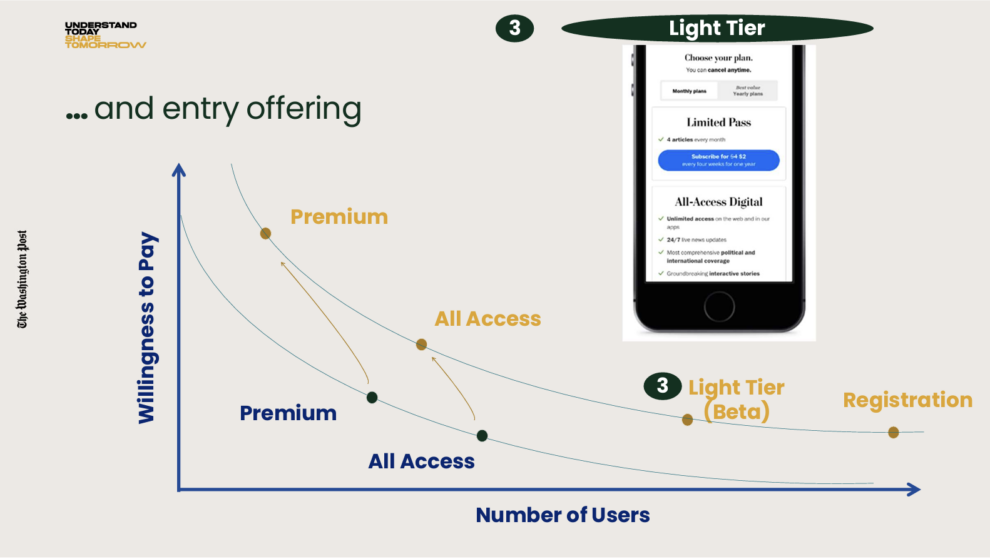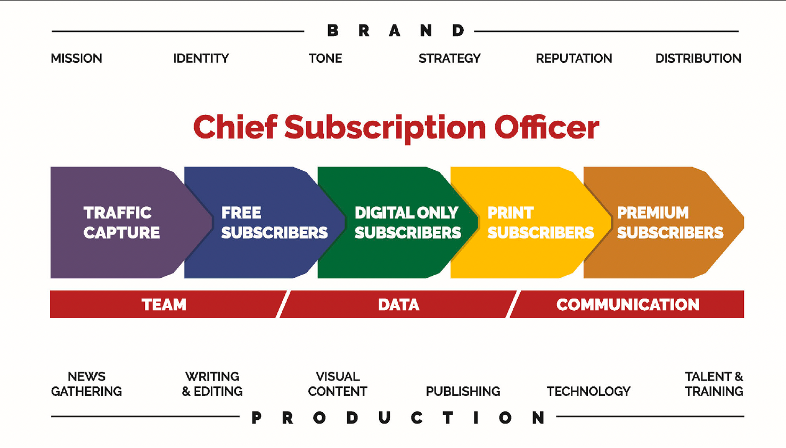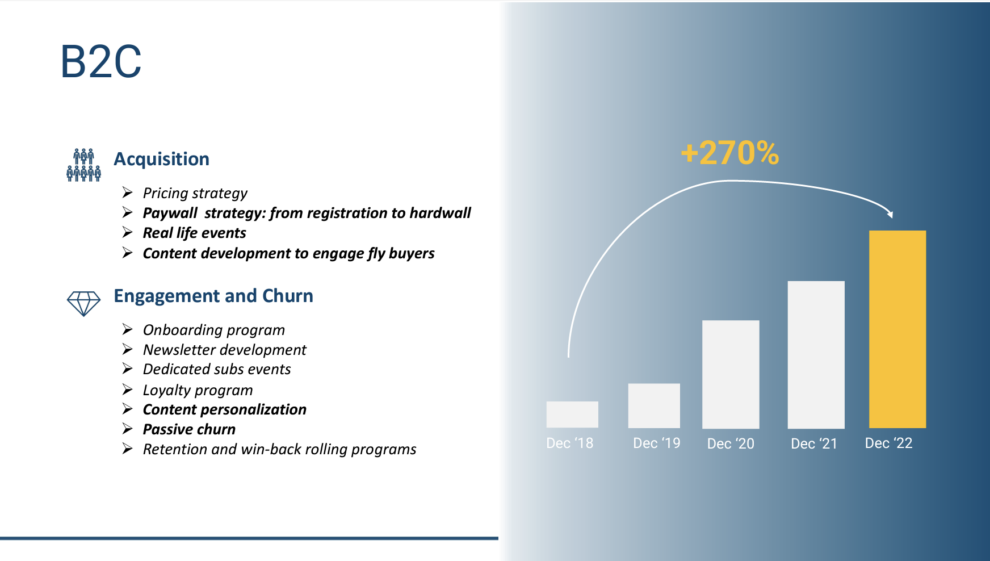Blog
5 Lessons from the INMA Media Subscription Summit
The INMA Subscription Summit in Stockholm brought together 355 attendees from 171 media companies in 34 countries to discuss the future of the news media industry and how to increase subscription revenue.
The gathering felt like a family reunion meant to share insights, best practices and success stories from newspaper publishers. From the many insightful speeches, cases and individual conversations, we have synthesised our key take aways from the conference.
Aside the celebrations, it was also a moment to reflect on the importance of journalism. Oksana Brovko, brought a powerful first-hand experience of reporting in the Ukraine war zones, which united the entire room and deeply moved all participants. If you are willing to help Ukrainian journalism survive and thrive, get in touch with her via Linkedin.

- 1. Simplified pricing is key in driving long term engagement
- 2. The case for de-anonymisation: Registered users are 11 times more engaged than anonymous readers
- 3. Bundling and unbundling are key strategies to increase revenue
- 4. The rise of the Chief Subscription Officer – Publishers need a holistic approach to Subscription Management
- 5. The Big Blindspot – Are we missing out on a big chunk of news reading behaviour?
1. Simplified pricing is key in driving long term engagement
Will Page, Chief Economist at Spotify, kicked off the summit with a talk focused on pricing strategies. The key message he passed is that newspaper publishers are shooting themselves in the foot by making pricing really complicated.
Will believes that Spotify’s success was partly driven by the simple understanding users have of the pricing:
- 1-month free premium trial
- 9.99€ monthly subscription
- A re-engagement offer of pay 1 get 3 months always available even after you cancelled your subscription.
You always want to be able to engage your customers and prospects and have them use your product
Will Page, Chief Economist at Spotify
Grzegorz Piechota also touched on paywall strategies and the rise of The Cyclone. This refers to the model used by companies like Boston Globe or Seattle Times to first drive conversion through a low and simplified entry price and then use the valuable data gathered to engage these newly onboarded subscribers.
💡 The Core Concept: Instead of engaging to convert, convert to engage!

Personalisation tactics play an important role for publishers leveraging a cyclone model. The ability to tailor offers for readers with different engagement levels or proving value with personalised content selection are key to optimise lifetime value.
Regional publisher, Keskisuomalainen in Finland has also experimented with a cyclone model and used JAMES personalised newsletters to engage the subscribers they converted with a promotion. 40-50% of onboarders were converted to full price after their 3-month reduced price phase, with some regions seeing more than 50% of onboarded readers turning habitual. This experiment has been selected as one of the finalist for the INMA awards.


While this strategy is well performing, it seems to be best suited for large publishers with a known brand.
2. The case for de-anonymisation: Registered users are 11 times more engaged than anonymous readers
Reader revenue growth has slowed down after the “corona bump” but turning anonymous digital readers into paid subscribers remains the main focus for many newspaper publishers.
The Independent found that more than 50% of their newly acquired digital subscribers come from registered users. Jo Holdaway, Chief Data & Marketing Officer at the UK newspaper, shared details of their A2K strategy, focused on turning anonymous readers into registered users and ultimately into engaged subscribers.
Registered users are 11 times more engaged than anonymous readers while subscribers are on average 62 times more engaged.
They started carefully dissecting each step of the journey and designing strategies to get readers to create an account. With a mix of registration gating, lead generation and newsletters they managed to bring a 7-fold increase in their newsletter’s list since April 2021.
💡 The Practical Tip: Design multiple ways to capture your readers’ emails and make it a focus of your organisation. This is the very start of any subscription and conversion strategy.
This has enabled The Independent to deeply transform its organisation and allowed them to:
- Improve subscription conversions by better understanding its audience
- Tailor Marketing communications based on a APV Model (Active Days, Premium Articles Mix and Volume)
- Categorize its content with a Read Scoring Model based on 4 buckets
- Acquire First-Party Data to foster sales of programmatic ads
- Further increase ads revenue with Newsletter Sponsorship deals

Re-organising around reader revenue has also been the focus at Mediahuis with the recent acquisition of German newspaper title Aachener Zeitung.
Nele Toye and Emmanuel Naert explained how Aachener Zeitung has re-organised its Newsroom with digital-first workflows.
With an ambitious long-term goal of acquiring 30.000 new subscribers by 2025, the regional german publisher set up a cascade of daily KPIs and revamping its product offering with a new modular, unified app built on Twipe’s most recent Apps v4 Platform. This provides all their valuable journalism in one product experience.

3. Bundling and unbundling are key strategies to increase revenue
To increase revenue, media companies need to find the right balance between giving readers access to the content they want while still generating revenue. By offering different subscription packages and pricing tiers, media companies can create more value for readers and increase revenue.
The efficacy of this content bundling and unbundling was flawlessly demonstrated by Michael Ribero, Chief Subscription Officer at The Washington Post. Leveraging demand curves from Econ 101, Michael has shown how The Washington Post was able to lift the Willigness to Pay (WTP) of their subscribers by adding a “Registration” and a “Light Tier” to their offering.
The hat trick is simple. First, The Washington Post has added value to their Premium package by expanding the content offering with new verticals (like the personal health section below) and bundling it into a all-in offering. Secondly, they unbundled such offering into a registration tier and a lower price one to convert a wider base of users with a lower WTP.
Lastly, empowered by the data collected on these new subscribers, they designed upselling journeys and experimented with different pricing points to maximise the customer lifetime value across different subscribers types.



Media giant Schibsted is also leveraging bundling in their race to double their subscription business by 2025. While historically revenue has been generated by selling subscriptions to their individual titles, Schibsted believes that in the future bundled packages offering access to multiple titles in their portfolio will be key to satisfy the needs of ever more sophisticated audiences with different areas of interest.
This belief was cemented in a key finding within their data. They observed that after 1 year only 13% of their subscribers would remain such while the rest were churning. Coincidentally, they observed that the exact same percentage of subscribers, 13%, were subscribed to 2 or more of the products in their offering.
Based on this insight and after extensive testing, they launched “Full Tilgang” in Autumn 2022, a bundle of their Norwegian titles that includes access to national, regional and finance news as well as magazines and their new podcast platform PodMe.
💡Pro tip: If you are looking into bundling offers, make sure you first get your Identity and Access Management centralised and develop a clear and consistent communication strategy
Since launch, they have acquired more than 22.000 subscribers and given the astounding success they decided to replicate this bundle strategy in Sweden launching “Superpaketet”, an all-access subscription offer with a higher price point.
According to Tor Jacobsen, Senior VP of Consumer and Subscriptions, this is only the beginning as they plan to further improve the existing bundles and create new ones including puzzles and reward mechanisms for loyalty.
4. The rise of the Chief Subscription Officer – Publishers need a holistic approach to Subscription Management
The news media industry is undergoing a transformation as subscription models become more prevalent. To succeed in this new landscape, publishers need to adopt a holistic approach to subscription journeys. This means that they need to tackle each step of the journey, from attracting potential subscribers to retaining existing ones, with a coordinated and integrated strategy. The rise of the Chief Subscription Officer (CSO), highlighted in the session from Rob Skorb, author of “Retention Point”, is evidence of this trend, as more and more publishers recognise the need for a senior executive who can oversee all aspects of the subscription business.

Le Monde and RCS Mediagroup are two examples of publishers that have successfully implemented a holistic subscription strategy.
Lou Grasser, Chief Marketing and Product Officer at Le Monde, shared how they have been operating at different levels of the subscription journey to maintain a sustained digital growth despite the post-covid slowdown.
They started by protecting the value of their paid content with 2 important actions: limiting the ability to read on multiple devices and disabling the option to copy paste content or to distribute PDFs. A project our team at Twipe has also been part of to ensure this is streamlined accross Le Monde‘s products.
This fed into their new segmented pricing strategy that replaces the single digital access with a Netflix and Spotify like model where the number of accounts that can access content is part of the value proposition.
Secondly, they devised a series of tests on their paywall with the goal to boost conversion. The most performing version was a straightforward “price paywall” with a different colouring that achieved an astounding +61% on Web and 128% on mobile in conversion rates. The experiment basically showed that the most immediate communication turned out to be the most effective.
💡The Learning: Digital purchases are most often instinctive. Be confident with your value proposition, test with different designs and keep pricing simple to understand!

Finally, they tackled churn rates, improving their customer service by:
- Optimising the update of payment methods and information: 90 days before the expiry of payment details for a reader they launch a dedicated communication journey based on mix touchpoints spanning from emailing, SMS, App Notifications and increasingly big banners on the website
- Implementing a phone unsubscribe workflow: instead of cancellation letters to boost win-back rates, they revisioned the marketing speech for each cancellation reason achieving an impressive 44% retention rate
RCS Mediagroup, the leading publisher in southern Europe, has also adopted a holistic approach to subscriptions. Its flagship title Corriere della Sera passed the 500.000 digital subscriptions mark in 2022, an uplift from 135.000 back in 2018.
This spectacular 3-fold increase was achieved by switching focus on subscriptions from advertising. Maria Sgromo, Head of Subscriptions and Fabio Napoli, Head of Digital shared their 4 pillars based strategy:
- Organisation Transformation
- Technology & Data
- B2B sales
- B2C sales
On organisation, the focus has been on moving towards a digital-first newsroom with a cross functional SEO Team and Central News Desk responsible and a fully autonomous Marketing Team, with vertical competencies on customer acquisition.
Both the Central News Desk and the Marketing Team were supported and informed by a dedicated Data and Analytics Team focusing only on subscriptions, who developed multiple models to segment audiences by propensity to convert and score content.
This revamped organisation was empowered with a new tech stack consisting of a Marketing Automation Platform and a Dynamic Paywall.
💡In a Nutshell: Moving to a reader revenue focused strategy requires a holistic approach to organisational change. The role of the Chief Subscription Officer is a cross-functional one owning the entirety of the subscription journey!
Leveraging these organisational changes, Il Corriere della Sera could implement multiple successful initiatives including, gradually moving from a mere volume business to one based on engagement:
- A/B testing a hard paywall instead of a 20-articles metered paywall for 10% of their users who had high propensity to engage
- Introducing a communication plan for expiring payment methods (like Le Monde) to address the passive churn which is 15% of their total churn
- Introducing a personalised web page called “Le tue Notizie” (your news) candidate to this year INMA’s awards
- A structured and rigorous approach to exploit “Real Life Events” with a differentiated approach for prospects and customers (e.g: Italian elections, music festivals, events)
- Win-back and loyalty programmes including benefits beyond news (meet the editors, exclusive events, tickets to La Scala theater)

5. The Big Blindspot – Are we missing out on a big chunk of news reading behaviour?
One important topic that emerged particularly from Will Page’s presentation was that since a lot of news consumption happens on platforms outside of publishers property, we may be taking decisions based on limited data.
In the past few months, some of the biggest headlines in the industry have been around the phenomenon of news avoidance, with 38% of people actively fencing off news from their lives as per the Reuters’ 2022 Digital News Report. Will Page spoke about the ‘Newspaper Trilemma’ that included the 3 forces posing a threat for traditional publishers: the aggregators, the social media shared news and the free sources.

What it emerged through Will’s presentation and the following panel with Rob Skorb and Angelica Velati, is that there is a large part of news consumers that has a variegated diet in terms of sources including Twitter, Substack, TikTok, Youtube and others for which publishers have no data for.
As an industry, we run the risk of becoming biased towards the preferences of our existing subscriber base, which is mostly composed of older individuals. By solely relying on their behaviour and interests to inform our decisions regarding content, products, and strategies, we risk hindering our subscription growth with younger audiences.
💡The Challenge: To grow news subscription businesses we need to go beyond our current audiences and reach for those news consumers for which we have no data. Look around you and trust common sense!
In our Seminar in NYC earlier this month we focused on How to engage readers across generations, the speakers talked as well about the need for newspaper publishers to increase brand value with the younger generations.
Cross generational engagement will also be the topic of our upcoming Digital Growth Summit on September 27th in Brussels, right before the INMA Media Innovation Summit in Antwerp. Fill in this form to pre-register for the summit.
Other Blog Posts

Stay on top of the game
Subscribe to Twipe’s weekly newsletter to receive industry insights, case studies, and event invitations.
"(Required)" indicates required fields


